- Home
- Colleen McCullough
Life Without The Boring Bits Page 15
Life Without The Boring Bits Read online
Page 15
In one way I can understand why, since well before I became a famous writer, people have nagged and picked at me to write an autobiography. Some people lead desperately dull lives, through no fault of their own; it’s just that they were always visiting the ski slopes the day before the avalanche, or the volcano the day before the eruption, or the bank ten minutes before the bloody holdup. There are other people who can hit Panama on the day of revolution and get stuck in the President’s palace, or Greece in the throes of the same, and get stuck in the middle of bloody riots in Thessalonika, or get mistaken for the great diva Joan Sutherland, or get stuck for ten days in a New York hotel during the Blizzard of ’96 — need I go on? The latter person is I. Things happen to me, and there doesn’t seem to be a way out of it. Birds crap on my head. Dogs hump my leg. Rats laugh at me, and don’t say rats can’t laugh, because they can.
When Ladies was published, I was accused of — wait for it! — plagiarism. If it hadn’t been such a shock, I would have seen the funny side a great deal more quickly; as it was, newspapers got into the act, and some old lady in New Zealand embarked on a wild vendetta because I had copied her favorite girls’ book author, one L.M. Montgomery of Anne of Green Gables fame. A bigger load of nonsense would have been hard to find, as my alleged plagiarisms were far from it. As best I could work it out, there had been a very successful TV series on Anne, and perhaps there were further TV series contracts in the wind — the publicity would have been excellent. Nothing came of it because nothing could, and later on I did laugh heartily — the one thing I have never needed to do is copy other writers! I add that any plagiarism involved L.M. Montgomery as much as it did me — we both had a go at Cinderella.
The incident put a wonderful seal on my career as a writer: if it can happen to anyone, it will happen to me.
The story of the Masters of Rome series of novels I want to save until last, as it is — at least to me — the most interesting and helpful of all my projects as far as other writers are concerned, especially if said writers aspire to historical novels.
The Song of Troy was a factual retelling of the ten years of war between Achaea (Greece) and Troy (Ilium): what might actually have occurred to give rise to the myth. However, I couldn’t bear to let go of the myth’s most wonderful trappings, from the flight of Helen with Paris to Troy, to the Trojan horse. Good historian that I am, I started my tale with its root causes, and went on through all ten years before tackling the culminating fifty-odd days chronicled by Homer in the Iliad. Then told of the fate of those among the heroes who survived the conflagration.
It has one distinction none of my other published works has: I wrote it when I was twenty years old, and didn’t destroy it. I liked it too much. Whereas, the day Tim was published, I burned the dozens of novels I had written over the years for my own private amusement. That there might be anything in my mother’s house I didn’t fear for one moment. Laurie was the original burner, and liked nothing better than burning her children’s “scribbling”.
My only work of non-fiction was a biography of a remarkable man, Sir Roden Cutler V.C. He was everything by accident, a soldier thanks to war rather than profession who won the Victoria Cross for an incredible feat of bravery, and was thrown into a diplomatic career at the whim of a Labor politician who saw his promise. Wherever he went, things happened, and that same coolness and daring that had carried him through his war experiences stood him in good stead.
Getting facts out of him was akin to squeezing blood out of the proverbial stone; I vowed I would never write another biography! But he was such a dear man. He died, aged eighty-six, a true hero. Our book did very well in Australia; it had no international market, alas, though it did see the light of day in the U.K. We donated the proceeds of Roden Cutler, V.C. to charity.
The genesis of Morgan’s Run was interesting. I had always deplored the Australian tendency to play down its convict origins, and found this nowhere more obnoxiously illustrated than in tales of the First Fleet, an occurrence as important for Australia as the Pilgrim Fathers for America. The convicts were passed over in favor of the British naval and marine officers who governed men and women they treated, by and large, at least as badly as slavers did slaves.
My husband, Ric, has a fascinating ancestry; he’s descended from two different Marquesses, Ripon and Hastings, from Fletcher Christian, Matthew Quintal and the Tahitians who took the Bounty to Pitcairn Island, and from a First Fleet convict named Richard Morgan who, oddly enough, was sent to Norfolk Island, where the Pitcairners too wound up.
Ric has a Robinson cousin, the famous singer Helen Reddy, who had accumulated a huge amount of documentation about Richard Morgan; Ric too had Morgan documents. It had been Helen’s ambition to write a book about Morgan, who is the four-times-great-grandfather of both Helen and Ric. But time had not permitted it; when I expressed an interest, she gave me all Morgan’s papers. I sent my stepdaughter to England on a further fact-finding mission, and out of this mountain of authentic fact came Morgan’s Run, the true story of a remarkable man. More satisfying still to me was the fact that it equipped me to write about the First Fleet from the convict point of view, until then, utterly neglected save for a very good non-fiction book by Robert Hughes, The Fatal Shore. But Hughes’s canvas was far larger, and the two books do not collide.
The novel did extremely well, and continues to prove popular in paperback, though it’s years since it was published.
And after that came my least loved book, The Touch.
If a drip of water can eventually wear a hole in a skull, then that was what happened to me. I couldn’t write Son of TTB, but to shut up my editor I wrote a book about another aspect of the Australian historical experience that involved the doings of a man and his family. Because I found it interesting, I chose gold mining, and from there ventured into the infantile petroleum industry. Some of my most respected friends love The Touch, but I despise it. Looking back, a good proportion of that despisal is due to its title, which I fought against with might and main for months to no avail. My editor, who shall be nameless but was a powerful man, refused to see its inanity, suggestiveness and misinformation. To him, it was the Midas touch. To me, it was plain awful, and published with an equally awful dust jacket. I couldn’t win, and I didn’t win. But nor did my publishers.
A book’s content may have all the earmarks of success, yet not achieve it. If I had my way, I’d re-issue it as Alexander’s Gold, which would at least put the emphasis where it should belong instead of upon some groping, clammy, furtive hand up the skirts of a female figure who, if her dust jacket face is anything to go by, is dead.
Actually, a good title would be Murder by Editor.
That I write about this kind of thing at some length is to dispel some of the myths that surround bestselling writers, who are deemed all-powerful when they’re not. Well, let me modify that: writers who produce the same book over and over do well. It’s the mavericks who run afoul of the system. Maybe the true unkindest cut is that, having produced another reasonable candidate for big success, my editor and publisher combined to kill it in a misguided marketing zeal. I find it fascinating that the person who produces the work is the lowest man on the totem pole.
Now we come to Angel Puss, which I don’t think was published in the U.S.A. My favorite book, a complete self-indulgence that I understood wouldn’t travel well, as I explained in the introductory paragraphs of this essay. It’s all about women, but what women! Nothing gets them down, nothing fazes them, nothing the entire male sex can do is capable of knocking them out of the game of living. They’re the unsung heroines, the salt of the earth.
Angel Puss is a funny, irreverent novel about grotesques and life outside the mainstream that takes a colossal poke at so-called Christian society. Meeting him at a literary lunch, the fearsome editor of the Sydney Morning Herald literary section told me that the book was so funny he couldn’t catch his breath for laughing. Though on one level it might be seen as a dirge for the plight
of women, Angel Puss is a paean for the might of women. I just love the book, which contains my favorite of all female characters, Mrs. Delvecchio Schwartz, in her element in a world long gone: Kings Cross in 1960.
Another reason why I love the book so may lie in the fact that a writer rarely gets a chance to laugh at and with her characters, but I did in Angel Puss. Long may that book live!
I had never written a true, formal whodunit, and I was determined to do so as my sixties crept onward. Emblazoned in my mind was a veritable toenail-curler of an opening for a scary whodunit, the only time in my writing career that I predicated a book upon an opening page. After ten years in neurological research at the Yale Medical School, I had a perfect Agatha Christie venue for my tale of blood and serial murders: a small, enclosed research unit whose members were all equally able to fit into the killer’s shoes. For that reason I plucked the city of Holloman, Connecticut, and the Ivy League university, Chubb, out of the pages of Creed, and set my whodunit in 1965–66, an era before DNA and forensics took all the joy out of police detection. My cop was an Italian-American named Carmine Delmonico, and the plot was diabolical. I called the book On, Off — a title that so flummoxed my editor that — he? she? — didn’t even argue. You have to wait until the last page to find out why it’s called On, Off into the bargain.
Another symptom of encroaching old age is that all the little ideas you’ve been toying with idly for decades you suddenly decide to act upon. And one of these crotchets was a dissatisfaction with the most sacrosanct of all lady’s novels, Pride and Prejudice. Any fool can see that the marriage between Elizabeth and Mr. Darcy was doomed from its beginning; Austen’s prose may be lovely, but her knowledge of human nature is pretty shaky, especially when it involves the male sex; the bulk of men may as well have lived on Mars, Austen knew so little about them.
I had hankered to write a sequel set twenty years down the track, and, having the time, I did so. Another aspect of P & P that fascinated me was whatever happened to the fifth sister, Mary, she of the atrocious singing voice, which is just about the only mention Mary gets. Austen clearly says Mr. and Mrs. Bennet had five beautiful daughters, indicating that Mary too was beautiful, so why was she so undesirable? An atrocious singing voice is easy to deal with — just tell the offender to shut up. Anyway, I had great fun inventing a life for Mary and in detailing the state of affairs between Elizabeth and Mr. Darcy; the original novel is so improbable that it gives the writer of a sequel carte blanche in terms of probability. Dependence and Independence seemed a good name, except that some would think that it involved the American Founding Fathers, so it became The Independence of Miss Mary Bennet instead. I had great fun writing it, I add.
Time now to discuss the Roman books. It was my French publisher gave them their collective name: The Masters of Rome.
As a part of my assault on the various sorts of novel, I had wanted to write a true historical novel. By that, I meant a book so carefully researched historically that it would have to be ranked with all the scholarly treatises on the subject: an historical work that never departed from what is known about the period as well as the actual subject and persons.
Because I am a people explorer, it had to revolve around an historical personage, so I started looking for candidates. Not King Arthur or Merlin or any of that mystical claptrap so beloved of women novelists! I was attracted to Napoleon, but he’d been done to death. No Middle Ages English Kings either. A Renaissance hero? No. China or some other part of Asia? I’m not an oriental scholar. Finally I lit upon Gaius Julius Caesar the Dictator — the great Caesar, in other words. Nothing of moment had been written about him at all. Thornton Wilder had written a small fantasy, but it was hard to find anything else. Right! Caesar it is, I decided. Only much later, snowed under by the research, did I understand why novelists had left Caesar severely alone — the amount of research was crushing.
I live on a five-by-three-mile speck in the middle of the ocean, a thousand miles from any major landmass, so I realized that I would have to acquire my own reference library, complete and all-encompassing. The multi-volume Cambridge Ancient History was already on our library shelves; I sat down with the old volumes (the new aren’t as good, in my opinion) VIII, IX and X to peruse their bibliographies. Anything I thought I might need, I bought; the services of a professional book searcher are invaluable in this sort of exercise, I hasten to say. As those books came in, I conned their bibliographies, and so it went, on and on, until I had works of scholarship on every aspect of the period Caesar lived through: everyday life, clothing, food, wine, the toga, domestic pets, the entire military gamut, roads and road-making, geography, climate, agriculture, pastoralism, the ancient names of rivers, mountain ranges, lakes, seas, towns; business and commerce, government and its structure, the law, courts, wild animals, architecture, shipping and shipping routes, ships, Latin obscenities, Roman provinces, client kingdoms, children, schools and education, rhetoric, furniture, brickwork, stone masonry, glass, ceramics, tools, machinery, and literally half a hundred other aspects of Caesar’s world. The habits of a resident of Rome as against a resident of a Roman town or a foreign town — attitudes of mind were as important as objects and people. I wanted to be so soaked in Caesar’s world that I felt more at home in it than I did in my own world.
I used a computer for nothing, probably because when I embarked upon the research, the PC was a novelty, and once I had a method worked out, it was easier to keep going than change horses in midstream. The object of everything was memory reinforcement. As I read a book for the first time, I took copious notes by hand on to pads. Then some, mainly facts, would be transferred to pink five-by-eight-inch cards, and stored by category, while the same facts as part of a narrative would be transcribed to pieces of paper on a typewriter. Then other pieces of it, or the same pieces, would be typed yet again because they were also needed in a different category of note. I had, for instance, when the research was done, 300 double-spaced pages on Cicero alone, more than that on Brutus, 200 on Cassius, 200 on Servilia (a tortuous research business), and on Caesar himself, 1,000 pages. Those notes, which I called my biographies, were kept in spring binders. Each war had its own notes. So did each battle. I knew the name of every tribe in Gallia Comata. I had culled Druidism from sources as far removed as Polybius, Caesar and Ammianus.
I estimate that each fact I found was handwritten at least once, but probably twice, and typed in three or four different places. My memory is formidable, and I fed it relentlessly.
When all the books were in, I had about 3,000 volumes, not all of much use; perhaps 100 were invaluable, but not compared to what are called “the ancient sources”. These are the writers of antiquity, published in the Loeb Classics, one of the world’s most important heritages: the original Latin or Greek is on the left-hand page, and the English translation on the right. I have all the Loebs, and someone gave me a typed translation of Valerius Maximus, not in Loeb. It’s in the ancient sources that one does by far the bulk of one’s research, ploughing through Pliny on the rose hip for pages looking for his brief digressions, like the stammering pontifex maximus. From Strabo I learned that the Queen of Bithynia’s dog bit her on the bum. The digressions are legion, and form the tiny stitches in one’s vast tapestry of events.
One needs insatiable curiosity and infinite patience.
The time line was the most difficult — exactly which year did such-and-such happen? I dug and fossicked and burrowed and scrabbled looking for evidence that would give me dates for this, that, and everything. I found them all, or at least my guess was as educated as anyone else’s from Mommsen to Badian.
When I was ready to start writing, my time line was better organized, I think, than any I’ve ever heard of. I started with a huge concertina-folded block of old-style computer paper, and put the end of it into an Olivetti typewriter that had an old-fashioned roller, easier for this kind of task. One of the most important things was that the paper should never, never tear along its per
forations. I wanted the finished product a continuously folded block. On the left side of the sheet was a column for the date: the rest of the line and however many following was for a description of the event — in summary. Working from my assiduously assembled notes, I started typing my block at 110 BC and finished at 27 BC. It took just about the entire block of 500 continuously folded sheets of paper, single-spaced during a description, with a triple-spaced gap between each date for visual clarity. The sheets tended to “walk” as I fed them through; I would have to straighten them every three or four pages. However, the result was neat and clear, date after date after date.
Very well! I had my time line block, but how to display it as I worked on my IBM typewriter? Ric made me an L-shaped device twenty inches wide out of hard, thin board. The IBM typewriter sat on the flat arm of the L; the vertical arm towered behind it. At its top this arm had a long, rubber-sheathed spring clamp. I sat my time line block of computer paper behind the L and fed its first page through a slot at the base of the tall L, then pulled it gently up and held it in place with the clamp. As I finished with a set of dates, I lifted the clamp and pulled more paper through with fresh dates, while the used dates fell down behind the L and were re-pleated even farther back than the original block. I have a very broad work area. So that every time I lifted my gaze from my manuscript, I was looking straight at the relevant dates on my time line. Only at the end of a book did I tear the block at that point, leaving me with seven lots of time line block, still neat, still folded.

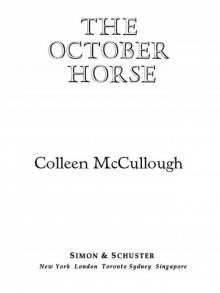 The October Horse: A Novel of Caesar and Cleopatra
The October Horse: A Novel of Caesar and Cleopatra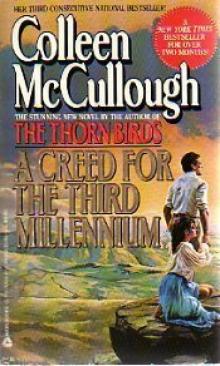 A Creed for the Third Millennium
A Creed for the Third Millennium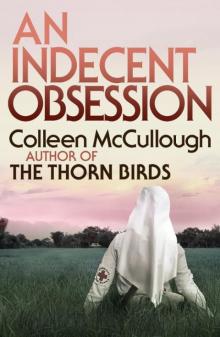 An Indecent Obsession
An Indecent Obsession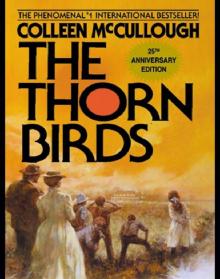 The Thorn Birds
The Thorn Birds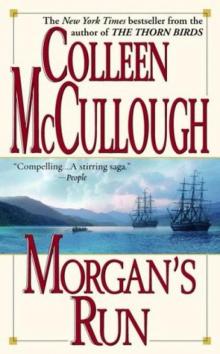 Morgan's Run
Morgan's Run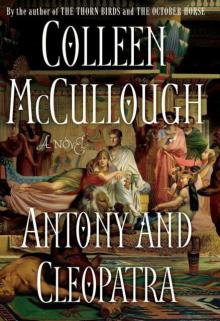 Antony and Cleopatra
Antony and Cleopatra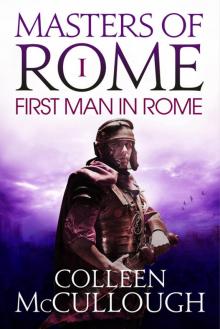 The First Man in Rome
The First Man in Rome Caesar
Caesar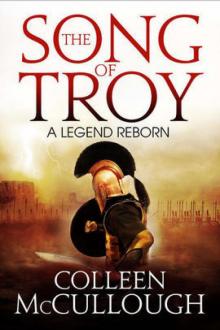 The Song of Troy
The Song of Troy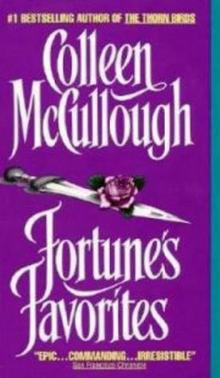 Fortune's Favorites
Fortune's Favorites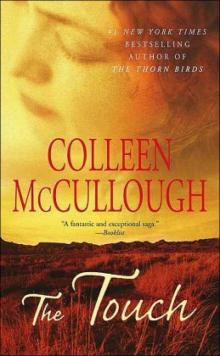 The Touch
The Touch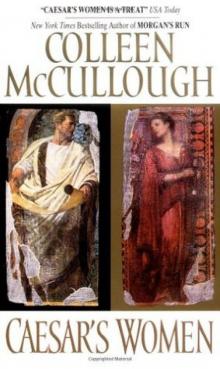 Caesar's Women
Caesar's Women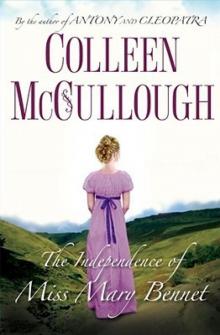 The Independence of Miss Mary Bennet
The Independence of Miss Mary Bennet The Grass Crown
The Grass Crown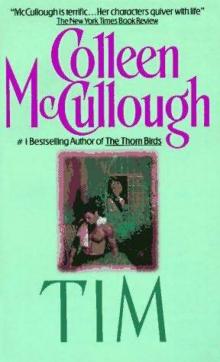 Tim
Tim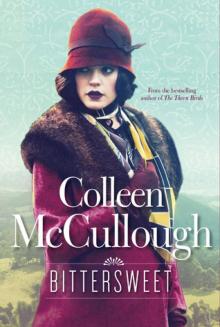 Bittersweet
Bittersweet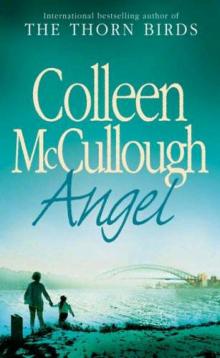 Angel
Angel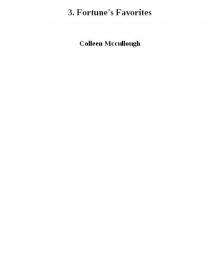 3. Fortune's Favorites
3. Fortune's Favorites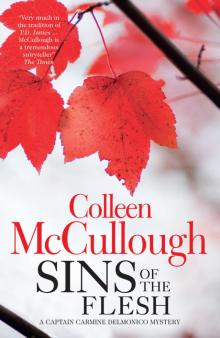 Sins of the Flesh
Sins of the Flesh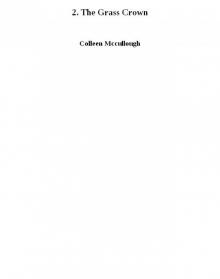 2. The Grass Crown
2. The Grass Crown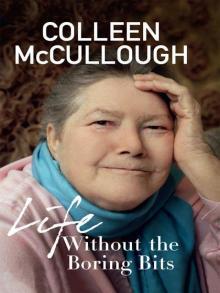 Life Without The Boring Bits
Life Without The Boring Bits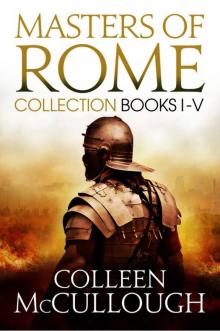 Masters of Rome Boxset: First Man in Rome, the Grass Crown, Fortune's Favourites, Caesar's Women, Caesar
Masters of Rome Boxset: First Man in Rome, the Grass Crown, Fortune's Favourites, Caesar's Women, Caesar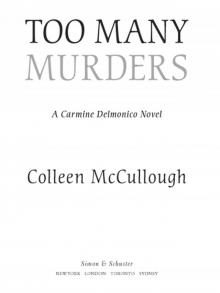 Too Many Murders
Too Many Murders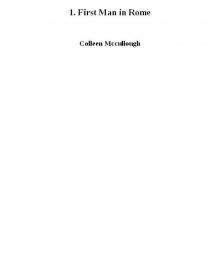 1. First Man in Rome
1. First Man in Rome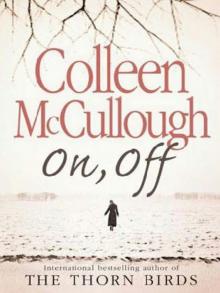 On, Off
On, Off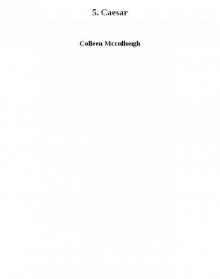 5. Caesar
5. Caesar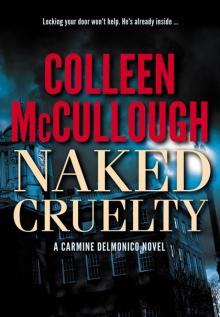 Naked Cruelty
Naked Cruelty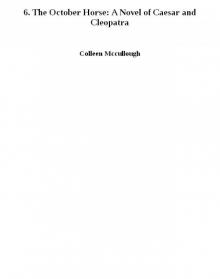 6. The October Horse: A Novel of Caesar and Cleopatra
6. The October Horse: A Novel of Caesar and Cleopatra